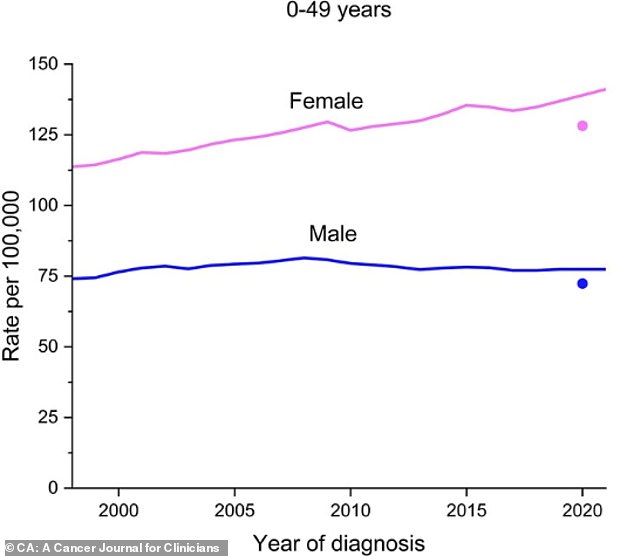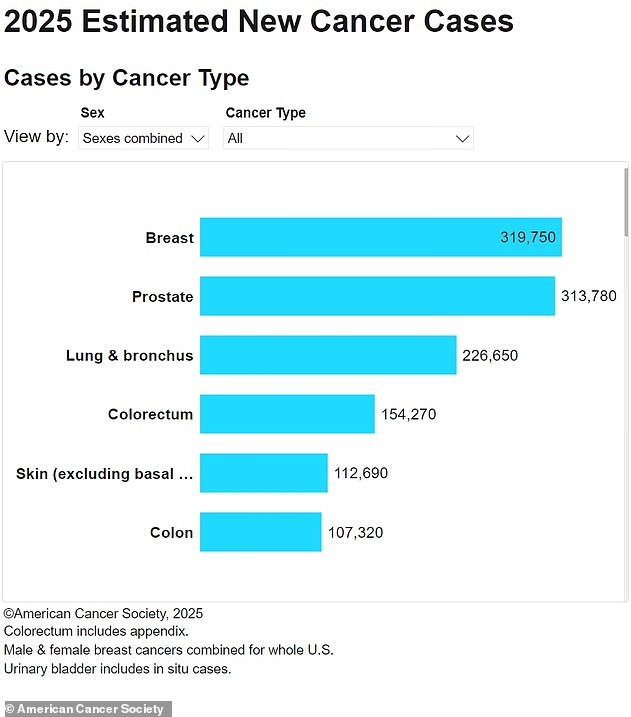The face of cancer in the US is shifting from older to younger patients – and from men to women.
Over the past three decades, cancer deaths have fallen 34 percent, leading to 4.5million fewer deaths over that period, according to the American Cancer Society (ACS) report.
But while rates of disease have generally declined among men, they appear to be climbing among women, especially young women.
Women under 50 are nearly twice as likely to be diagnosed with cancer than men in the same age group, a 50 percent surge from 2002.
Meanwhile middle-aged women now have a slightly higher risk than their male counterparts.
Breast and thyroid cancers in women appear to be driving the increasing trend, but what’s causing higher rates of those cancers is still being understood.
Experts say women’s changing fertility patterns, having fewer babies and having them later in life, could be causing physiological changes that helps cancers grow.
Pregnancy and breastfeeding have been associated with a reduced risk of cancer later in life.



But other factors are likely at play.
Recent research shows women under 50 drinking are drinking more alcohol than men.
One study, for example, found that the rate of women consuming five or more alcoholic beverages in a row rising twice as fast as men in the last decade.
Meanwhile, increased exposure to environmental toxins like radon could offer possible explanations.
Rebecca Siegel, senior scientific director of surveillance research at the American Cancer Society and lead author of the report, said: ‘Continued reductions in cancer mortality because of drops in smoking, better treatment, and earlier detection is certainly great news.
‘However, this progress is tempered by rising incidence in young and middle-aged women, who are often the family caregivers, and a shifting cancer burden from men to women, harkening back to the early 1900s when cancer was more common in women.’
The researchers compiled cancer incidence data through 2021 and mortality data through 2022.
They found that in 2021, women under 50 had an 82 percent higher cancer incidence rate than their male peers.
Dr William Dahut, chief scientific officer for the American Cancer Society, said: ‘We see for the first time, if you’re a woman under the age of 65, you’re now more likely to develop cancer than men in that same age group.



‘The other thing is, we’re seeing a change in – at the time of cancer diagnosis – the age of which patients develop cancer.
‘Age remains the number-one greatest risk factor for cancer overall, and that hasn’t changed. But we’re seeing some shifting.’
He noted for men and women combined, ‘the only age group where we’re seeing actually an increase in cancer risk, in incidence going up, is under the age of 50.’
Overall, the ACS estimates just over 2million new cancers will be diagnosed in 2025, and there will be 618,120 deaths.
This adds up to 5,590 new cases and 1,690 deaths every day.
Breast cancer is expected to be the most common cancer diagnosed in 2025, with 319,750 anticipated cases.
Prostate cancer, which only affects men, followed closely behind with 313,780 expected cases.

Dr Dionisia Quiroga, a breast medical oncologist at The Ohio State University Comprehensive Cancer Center, told Stat News the shift of breast cancer from older to younger women could be due to rising incidences of early menstruation and delayed childbirth.
She said: ‘People who tend to have their periods later or have children earlier in life are actually more protected from having breast cancer develop.
‘And part of that has to do with estrogen exposure and the fact that most of these new breast cancer cases are estrogen receptor-positive breast cancers, which are triggered by estrogen in the body.’
In 2025, breast cancer is estimated to make up up one in three new cancer cases and 14 percent of deaths in women.
The rise of young women with breast cancer began making headlines last year when actress Olivia Munn revealed she had been diagnosed with the disease at age 43, just two months after receiving the all-clear from a mammogram.
Munn has since undergone a double mastectomy and encouraged women in their 30s and 40s to get screened if they notice symptoms.


She said last year: ‘I’m lucky. We caught it with enough time that I had options. I want the same for any woman who might have to face this one day.’
Annie Bond from Los Angeles was just 26 years old when her boyfriend noticed a lump in her breast.
Though doctors insisted she was ‘too young’ to have breast cancer, an ultrasound and biopsy would reveal stage four breast cancer that had spread to her liver.
Ms Bond had her ovaries removed to stop the production of estrogen, which was feeding her cancer, as well as a lumpectomy to remove the lump from her breast and a liver resection.
Eight years later, she is managing her cancer with chemotherapy and sharing her story on social media to spread awareness.
She said in a recent Instagram Reel: ‘I am so grateful and happy and lucky to be alive.
‘If I can tell you one thing to do, it is please do self checks and please advocate for your health.’



The report also found that the rate of lung cancers is higher in women than men, with it accounting for 12 percent of all cancers in women compared to 11 percent for men.
Lung and bronchus cancers are estimated to be diagnosed 226,650 times in 2025. The disease is also expected to cause the most deaths with 124,730.
This is nearly two and a half times the deaths caused by the next deadliest form of cancer, colorectal cancer.
The anticipated number of lung cancers is down slightly from about 234,000 in 2024. Deaths have also decreased slightly from 125,070.
Recent research from the National Cancer Institute found that lung cancer rates decreased 1.8 percent per year from 1991 to 2018, which experts believe is due to lower smoking rates.
According to the American Lung Association, 12 percent of US adults smoked cigarettes in 2022 compared to 43 percent in 1965.
Smoking is the leading cause of lung cancer, responsible for nearly nine in 10 cases. However, the ACS researchers also pointed to exposure to radon gas.
Radon is an invisible, odorless gas produced from the decay or uranium in rocks, soil, and water.
Radon has been shown to enter homes through contaminated soil, and a 2019 report in Nature suggested its exposure in homes has increased due to modern construction being more airtight.
A growing number of young lung cancer patients report never smoking or being knowingly exposed to toxic gases.
One of them is Tiffany Job, a nurse and mother of twin boys in Texas.
She first thought she pulled a muscle at age 37. But within weeks, she developed a persistent cough and could hardly walk a few steps without becoming out of breath.
Scans would reveal she had stage four non-small cell lung cancer that had spread to her pelvis, right femur, and neck.
She claims she never smoked a day in her life.
Despite qualifying for a clinical trial, Mrs Job posted on Instagram in September that her primary lung tumor is growing and her current treatment is no longer effective.
The ACS report also found colorectal cancer, which has surged in young Americans in recent years, is expected to affect 154,270 Americans and kill 52,900.
A recent report from the University of Missouri-Kansas City found that rates of colorectal cancer have risen in all age groups over the last two decades.
Colon cancer rates increased 500 percent among children ages 10 to 14 and 333 percent among teenagers aged 15 to 19 years.
Rates rose by 71 percent among people 30 to 34 to seven cases per 100,000 people. Among people 35 to 39, rates rose by 58 percent to 12 cases per 100,000 people.
The ACS report found rates of colorectal cancer have increased in both men and women under age 65.
The team said 54 percent of colorectal cancers ‘are attributable to potentially modifiable risk factors, including excess body weight, physical inactivity, long-term cigarette smoking, high consumption of red or processed meat, heavy alcohol consumption, and low intake of calcium, whole-grain, and/or fiber-rich foods.’

DailyMail.com has extensively reported on young Americans living with colorectal cancer.
Evan White, from Texas, had just graduated from the University of Arkansas with a degree in finance when he was diagnosed with colon cancer after dismissing his main symptom – tiredness – for months.
The tumor was not spotted until it had progressed to stage three, meaning it had spread outside the colon, making it much harder to treat.
He died at age 29, just before his wedding.
And Bailey Hutchins was in her early 20s when she started burping constantly and suffering severe acid reflux and bloating.
Her family has started a GoFundMe for her medical expenses.
At 24, she was diagnosed with stage three colon cancer, which has since advanced to stage four and spread to her peritoneum, the lining the abdominal cavity.
Ms Hutchins said in a recent TikTok video: ‘A change to your normal is not normal, so you need to get it addressed.’

